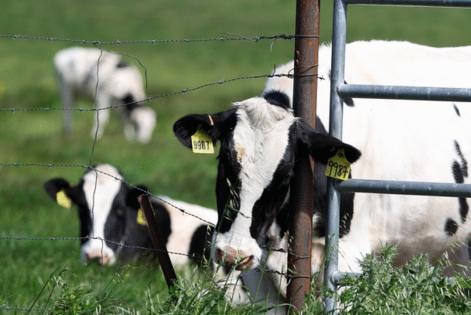Lisa Jarvis: The bird flu outbreak has more questions than answers
Published in Op Eds
As the magnitude of the bird flu outbreak in cattle becomes clearer, so does the need to quickly get a firmer grip on some basic facts. Namely, how far this H5N1 virus has spread, how it is spreading, and where this situation is likely to go next. The COVID-weary public also wants to know whether humans are at risk.
Public agencies must move faster and collaborate more efficiently to answer some of those unknowns. After all, this is a pathogen that has loomed large in the minds of infectious disease experts for its potential to cause a deadly human pandemic.
“It’s fair to say for every question we’ve had answered in the last month, we have 10 to 15 new questions,” says Michael Osterholm, director of the Center for Infectious Disease Research and Policy in Minnesota.
Among the most essential: Just how widespread is this outbreak?
The seriousness of the situation escalated after scientists found viral fragments in milk on grocery store shelves—including in states that had not reported infected herds. The Food and Drug Administration eventually said it had detected H5N1 fragments in one out of every five of the commercial milk samples it tested.
That suggests the virus has been circulating in cows longer and more easily than anyone realized. Genetic sleuths have traced the outbreak back to a likely spillover event in late 2023, when a wild bird may have infected a cow on a farm.
Widespread testing is essential to understanding the outbreak’s true scope — and to have any hope of containing it. But that’s easier said than done. Consider that tens of thousands of cows are being moved around the country any given week, says Keith Poulsen, Director of the Wisconsin Veterinary Diagnostic Laboratory at the University of Wisconsin-Madison. “We can’t test them all, so we need to test where it’s going to be logistically easy to accomplish.”
The US Department of Agriculture recently said cows could not be moved between states without a negative H5N1 test, and expanded the amount of testing it will pay for. But the agency is still only requiring farms to test a few dozen cows out of each group, an approach that is not sufficient to stop the spread.
Paulsen and others are working on methods to test bulk milk, but need to ensure they are sensitive enough to pick up even one infected cow out of a pool of milk from as many as two thousand. Because even asymptomatic cows seem to be shedding so much virus in their milk, he thinks that’s feasible.
Which leads us to another seemingly simple, yet still elusive question: How exactly is the virus spreading among cows?
On a recent call with state public health officials, USDA Chief Veterinary Officer Rosemary Sifford noted that transmission is mostly occurring within cows who are lactating, but it’s unclear if the spread primarily is happening through the milking process itself or because a cow with a high viral load in their milk is passing it onto others. The USDA has said that anything that comes in contact with milk, whether that’s a human, another animal, a vehicle or fomites, could spread the virus and that it’s likely occurring in more than one way.
So far, the virus really seems to be largely in the mammary glands, though the USDA has found evidence of the virus in the respiratory tract of one cow (though it’s unclear how many nasal swabs are being performed). The agency is currently conducting transmission studies in cattle that could inform mitigation efforts.
Of course, everyone is wondering what the coming weeks and months will look like — for herds, for our food supply, for other livestock and, of course, for humans.
To help answer that, attention should focus on the Texas panhandle, where the outbreak was first detected. Those herds might provide important clues about what the coming months could look like. “Maybe the simplest question is: When a herd ‘recovers,’ what does it mean?,” asks Richard Webby, a specialist in influenza at St. Jude’s Children’s Research Hospital in Memphis.
We need to know whether cows generate sufficient immunity to ward off another infection, how long that immunity might last, and how widespread that immunity might be. That will mean looking for antibodies to the virus in herds around the country, regardless of whether there was a known outbreak there. Clarity on immunity will help shape future mitigation and monitoring efforts.
Which leads us to the questions most relevant to the general public: Am I safe?
Let’s start with the food supply. The FDA’s tests have shown pasteurized milk is safe to drink. (Raw milk, on the other hand, should be absolutely avoided.) And the USDA, which maintains the meat supply is safe, nevertheless is currently conducting tests of both ground beef on grocery shelves and at processing facilities, to understand whether evidence of the virus exists there, too. The agency is also looking at what happens to meat infected in a lab and then cooked at different temperatures.
Then there’s the worry of infection. Osterholm, who has been following H5N1 for nearly three decades now, reiterates that despite this new twist of widespread infections in cows, the risk to humans remains low. But “that should not leave us complacent,” he says. “All can change in a heartbeat.”
Some scientists are working behind the scenes to prepare in case the virus adapts to infect humans. So far, the same antivirals used for the seasonal flu, such as Tamiflu, seem likely to work against H5N1. Meanwhile, two vaccine candidates against H5N1 seem somewhat effective against viral samples taken from infected cows, and enough raw materials exist to make limited doses if needed.
But the caveats are many. For example, our flu treatments aren’t great to begin with — to be effective, they must be taken within a very short window of developing symptoms. And there’s reason to worry that our existing vaccines might be far less helpful if the virus adapted to infect people. Researchers are working on newer antivirals and vaccine strategies, but those efforts are nascent and wouldn’t do much for us if the situation suddenly took a more serious turn.
It's important to keep pushing for answers and transparency. The stakes are too high to let the questions keep piling up.
____
This column does not necessarily reflect the opinion of the editorial board or Bloomberg LP and its owners.
Lisa Jarvis is a Bloomberg Opinion columnist covering biotech, health care and the pharmaceutical industry. Previously, she was executive editor of Chemical & Engineering News.
©2024 Bloomberg L.P. Visit bloomberg.com/opinion. Distributed by Tribune Content Agency, LLC.







Comments